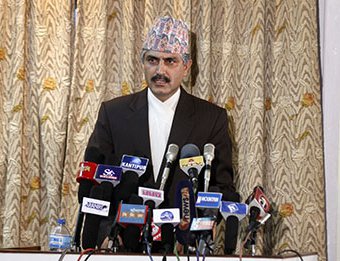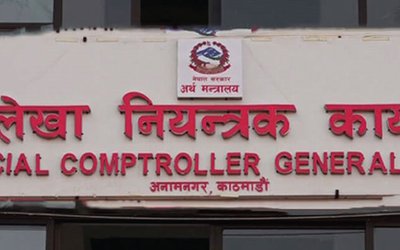
Along with the bleak political scenario, the economic picture of the country is going far being rosy. Even the recently presented budget failed to bring any substantial policy interventions to address it. The Economic Survey 2012-013 presents a dismal picture with total output expected to be lower in 2013 than originally expected in forecasts made last year.
The projected underperformance is mainly because of political instability and bad monsoon. The high imports and lower growth, depressed confidence, financial market fragmentation, weak balance sheets, and fiscal consolidation are leading Nepal’s economy to bleaker days ahead.
The overall situation is rather grim for the economy and careful navigation is needed to come out of the situation. The economy has already slowed down substantially, investments are low and interest rates are high. In addition, the domestic currency has been depreciating rather rapidly for which many in the markets were not prepared.
Although the previous government predicted that the economic growth will be 5.5%, Nepal’s economic growth in the fiscal year (2012-13) remained at 3.6%. For the past 10 years, the growth rate was recorded 3.7% in average. Both these figures achieved were far below the expectation, according to experts. With the growing political instability, the economy seems to be heading towards a more difficult situation.
“The government led by retired bureaucrats failed to address the real economic problems. By bringing a populist budget, the present government showed that it is like an election government of political parties,” said Tul Raj Bashyal, former economic advisor to Finance Minister. Despite over ambition of the budget, the budget allocated low capital expenditure like in the past years given the present trends of less foreign aid and growing concurrent expenditure to pay salary.
Although Nepal targeted to bring down poverty to 21 from 25.2%, poverty got reduced marginally by 1.4 to settle at 23.8%.Nepalese currency depreciated by 8.2% against the target of keeping it below 7.5% mark. It impacted the exchange rate adversely as Nepalese rupee went up to as high as 97 for one US dollar. It was the highest exchange rate of Nepalese currency so far.
Nepal’s trade deficit also widened excessively. Its total trade deficit was recorded $4.57bn in the past one year as its imports rocketed by 21.2%. Nepal’s only positively performing key sector was revenue collection. A total of $2.92bn revenue was collected across the country, but this achievement, too, was mainly due to the unsustainable customs duty levied on the imports into Nepal.
“The major challenge to our economy is to achieve a high level of economic growth. But there are many obstacles on its way,” said Shankar Koirala, minister of finance.
Others argue that there is the need to improve the agriculture sector to achieve high economic growth.“Poor performance of agriculture sector was the main reason for last year’s low growth rate,” said Rewat Karki, an economist with Nepal Rastra Bank, the central bank of Nepal.
“The climate was unfavorable last year, while farmers did not get the fertilizers in time,” said Karki. Only by arranging proper irrigation and facilities to farmers in time could we increase the growth rate next year. But I’m not that much hopeful, as there are plenty of problems including uncertainties in government policy, minimum role of private sector and the lack of a full-fledged budget,” said Karki.
New Budget, Old Practices
The new budget is also not much different from the old ones. Focusing on the upcoming Constituent Assembly (CA) elections and hydropower sector, among others, the election government’s full budget is Rs 517.24 billion for fiscal year 2013/14. Allocations for the Constituent Assembly (CA) elections and double-digit hike in the salary of civil servants have significantly jacked up recurrent expenditures.
“At a time when the recurrent expenditure rises, failure to generate revenues and foreign aid will have significant impacts on the capital expenditure. Low capital expenditure will adversely affect the investment in economy, production and productivity and employment indicators,” said Bashyal.
The government expects to mobilize revenue of Rs 354.5 billion in fiscal year 2013/14, raising the collection target by 19.87 percent compared to what it has estimated to mobilize in the current fiscal year.
Highly ambitious with few spaces to increase the revenue, the government has allocated Rs 353.42 billion or 68 percent of the budget for recurrent expenditure, Rs 85.10 billion or 16.45 percent for capital expenditure and Rs 78.72 billion or 15.22 percent for financial management. Without adjustment of any tax rates, the budget plans to mobilize Rs 354.5 billion through revenues, Rs 69.54 billion through foreign assistance and the deficit through domestic borrowings.
The government has made some attempts to get 5.5 percent economic growth with high priority in agriculture, education, irrigation, infrastructure, energy and exports promotion in the coming fiscal year. Amid double digit inflation, the budget has also set target to contain the inflation at 8 percent.
“We appreciate that government has come up with full-fledged budget with some incentives to boost confidence of private sector. The budget has also recognized the role of private sector in the economy,” said Bhaskar Raj Karnikar, Senior Vice President of Nepalese Chambers of Commerce and Industry (FNCCI).
The bottom line in the budget profile is that deficits would increase to an unprecedented Rs 87.7 billion, more than three times the estimated level for 2012/13. Of course, the deficit would need to be financed, which means the need for a large-size borrowing. Financing targets call for Rs 30.3 billion to be borrowed from foreign sources and Rs 43.1 billion from domestic sources, of which Rs 22 billion is needed for principle repayments.
This means that if expenditure and revenue targets are met, domestic borrowing requirements will be much larger, in the range of Rs 50 billion to Rs 60 billion. This translates to lots of money and unsustainable debt.
Experts argue that it needs to be mentioned that the government’s zeal to develop the economy has sunk the country deeper and deeper into the debt-hole. Annual debt servicing—interest and principal repayments—on accumulated government debt has reached Rs 40 billion, a sizeable part in foreign debt, which represents a loss of national savings.
An even more disturbing aspect of the debt scenario is that there is scarcely any evidence that debt commitments—foreign and domestic—have helped improve growth and living conditions. Actually, the inflows of debt and grant money from overseas have nourished a corruption culture and driven the more productive parts of the economy underground.
“We may assume that actual spending cannot be as high as projected, from the simple logic that many of the mega-expenditure items, especially in the capital category, aren’t ‘shovel ready’. Major hydro power projects (Rs 4.66 billion); transmission lines (Rs 13.5 billion); Melamchi (Rs 5.2 billion); postal highway (Rs 2.2 billion); new airports (Rs 1.8 billion); railway (Rs 1.4 billion); road bridges (Rs 3.5 billion); and large irrigation projects (Rs 4 billion) won’t be able to absorb such huge allocations in a single year,” writes Sukhdev Shah, in his article in Republica.
This budget or that budget cannot bring any changes. Along with bringing political stability, Nepal needs to have strong economic performance to maintain high economic growth. For this, Nepal needs a political leader to address its economic agenda.

Debesh Adhikari
Adhikari is a computer science student and writes on various contemporary issues.
- The UK Expressed Deep Concerned About Tensions in Nepal
- Mar 09, 2017
- Development Partners and Ministry of Education Agree to drive quality education
- Sep 28, 2016
- END HUNGERNepal plans to end hunger by 2025
- Mar 14, 2016
- UK Hopes For Inclusive Resolution For Nepal
- Sep 17, 2015
- Micromax Launches Bolt D320 For Nepali Market
- Aug 07, 2015
















